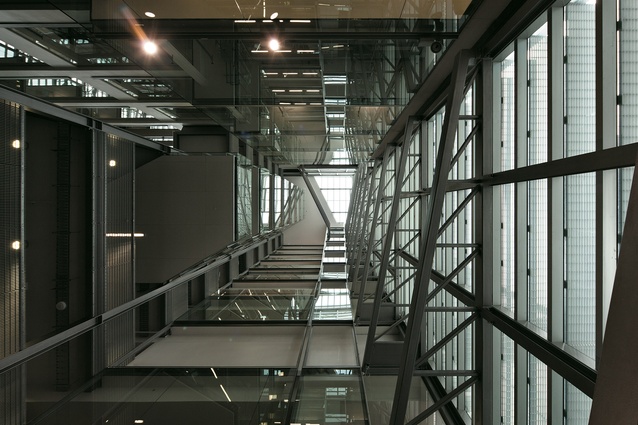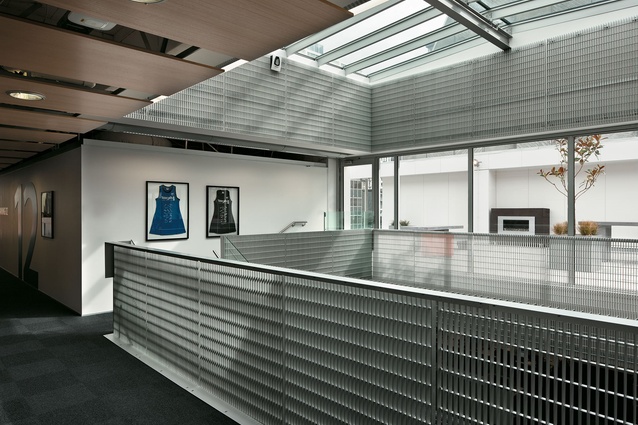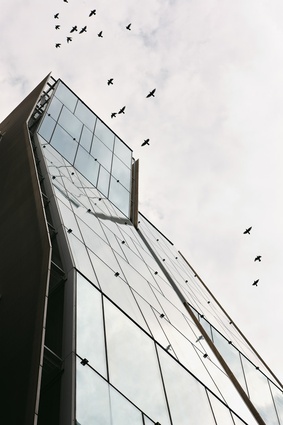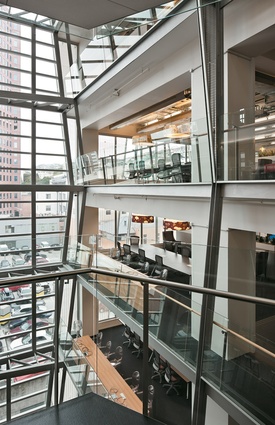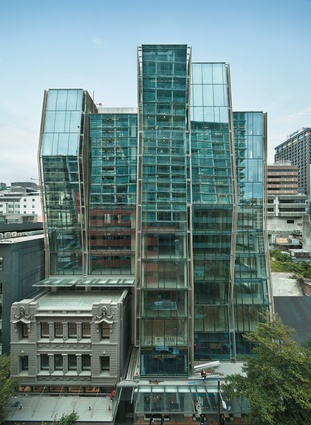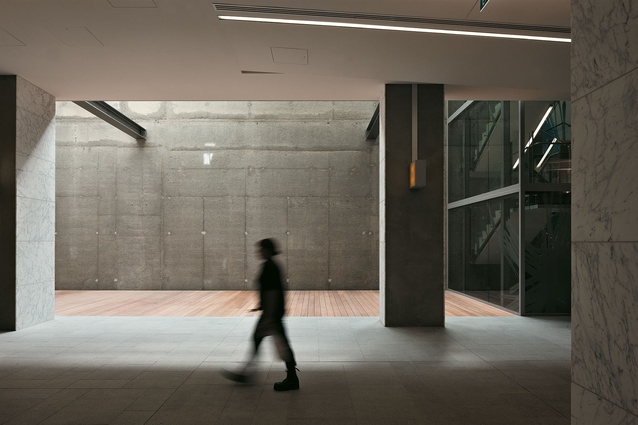Telecom Central by Architecture+
Looking upwards on Wellington's Willis Street is a wonderful spectacle - the articulated facade of an office building.
Clients, stakeholders, customers, patrons, occupants, consumers, users: regardless of the euphemism you use it is a statement of fact that buildings serve people. How well they do so is one of the more important tests of a building’s success. Christchurch has tragically proven the importance of designing for extreme events to protect people from buildings. It is both desirable and inevitable that New Zealand architects and engineers keep such events in mind as they make decisions concerning the shape of our future urban environments. Legislation will ensure that. But, what of the quality of the constructed world outside of emergencies and catastrophes? What ensures the quality of buildings when they serve no more that the mundane, ordinary routine of our daily lives? Little, it seems to me, other than the integrity of the professionals involved, and accountability of this kind is made more difficult when you consider that it is impossible to think of a building as being in service to an individual.
Even a modest house entertains whole societies as the lives of families, friends, visitors and neighbours all pass through in some capacity. When the project is a major commercial development, the number of vested interests increases exponentially with each holding quite different expectations. Telecom Central, under the guidance of Architecture +, proves this. To appreciate in full the complexity of expectations involved, it is helpful to explore the key client groups individually.
The Pedestrian. In small instants, Wellington is a city able to successfully masquerade as a genuine metropolis. Willis Street is such an instant. It is too narrow for the frontages that canyon-ise it and too short for the stream of traffic that flows along it. Like Huka Falls, it is a petite local occurrence with the drama of an international phenomenon through which people are carried. For the casual perambulator, Telecom Central at street level, suffers the same fate as most recent retail frontages. It is modern but otherwise bland in its commercial ambitions, in that it depends on the quality of street tenancies to lift the experience. But, looking upwards brings the wonderful spectacle of the articulated cliff-façade viewed through the glazed canopy.
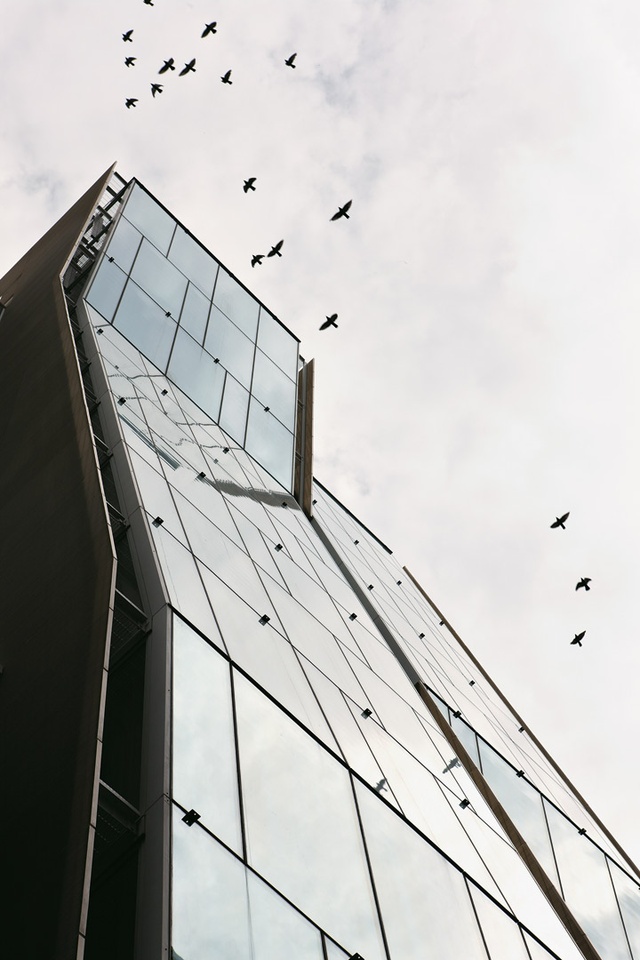
Wellington is remarkable for its pioneer pedestrian: the kind of individual who marches to work with the pragmatic determination of Scott heading to the South Pole. For the intrepid, Wellington’s CBD is negotiated vertically as well as horizontally as stairs, escalators and elevators all ease the movement between The Terrace and Lambton Quay. Telecom Central thoughtfully recognises this by providing workday egress between Boulcott Street and Willis Street via a lift. Unfortunately, at the moment, it is as desolate as Antarctica with empty commercial space aplenty but there is obvious potential here for a kind of micro-mall experience that takes in the volume of the atrium and a rugged courtyard. My only criticism is that it works a bit better coming down than it does going up due to the ‘dead-end’ of the ground level lift approach.
The Smoker. You don’t so much design for smokers as around them. Smokers are to the street what cats are to a room; if there’s a nice spot, they’ll find it and then make everything else walk around them. In this case, the smokers have decided that the Boulcott entry is the choicest spot. I think they are right. The scale of the building is brought right down to the street and, combined with a generous set-back and some attention to urban furniture, the building provides welcome respite on bad and good days. There is even a nice view across to Antrim House, the headquarters of the Historic Places Trust. It is a space that manages to be gritty and colonial at the same time. It’s just a shame about all the smokers.
The Major Tenant. As the building’s nomenclature suggests, the principal tenant is Telecom and it occupies a modern and vibrant workspace. As is often the case, many of the spatial features used here are not new but they are intelligently done. In resisting hierarchical planning (as much as is possible in a corporate environment) and maintaining relationships with view planes and vertical volume, it is a building that most reminds me of Herman Hertzberger’s Centraal Beheer from way back in 1970. Telecom Central shows the same commitment to infrastructure – building and organisation – operating as a small settlement and, in principle, this should provide a capacity to accommodate future changes in work patterns.
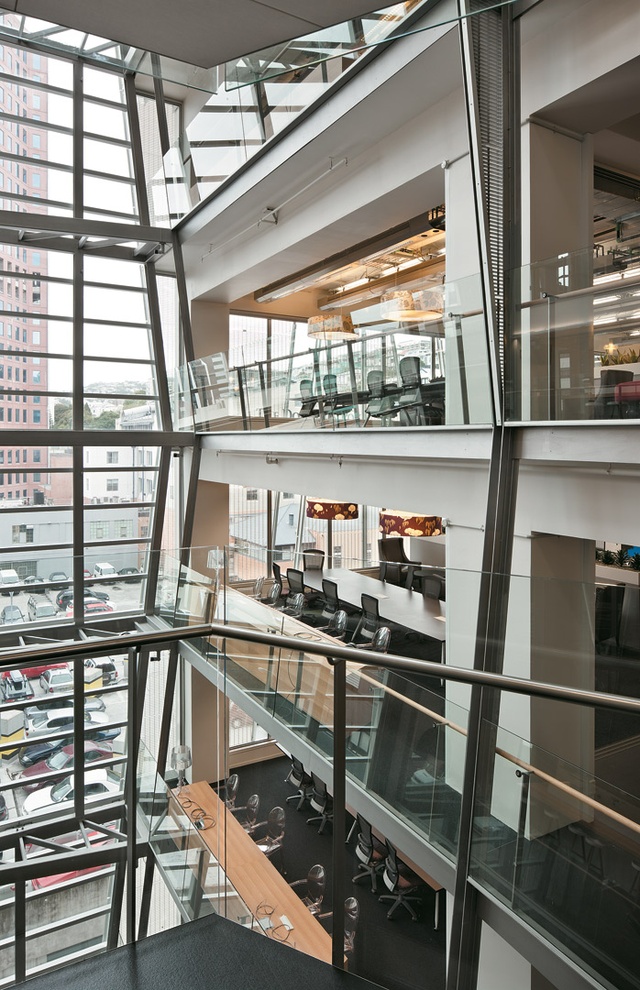
I did find the entry to Telecom Central disconcerting. One is transported upward by a unidirectional escalator to a slick reception area that conceals its security thresholds well with open lines of sight and more natural lighting than you could hope for. Unless, that is, you came up the escalator by mistake, in which case you feel very much like someone who blundered into an airport boarding check by mistake and from where backtracking means publicly admitting you’re not the flying type. In Telecom Central, the equivalent indignity is waiting for the closed lift to the ground floor while the secure exposed lifts are launched into the heady atrium space above.
The Developer. An individual cannot be a company but a company can often be the work of an individual with vision, and this certainly seems to be the case with Ian Cassels, the man behind The Wellington Company, which is the company behind Telecom Central. This is only the latest in a series of commercial developments for Cassels over the last 20 years but it is probably the most ambitious and prominent to date. Cassels is a businessman and, by definition, we should expect that his first expectation of a development is that it is commercially viable. What sets this development apart is the confident view that ‘viability’ incorporates active environmentalism. As an example, the Telecom Central building has received Green Star NZ certification in recognition of systems that include chilled beams, grey water collection and solar water heating. Resource-sensitive buildings are becoming increasingly common and they point to a recognition that we all benefit when buildings are more responsive. Moreover, it is equally clear that an association to such buildings is strategically desirable and therefore also good for business.
The Architect. Finally, what did the architects get out of this? Well, we might hope that they were paid heaps or embraced the opportunity to do something, you know, really big-arse. But I think there is more to this for Architecture + than grubby cash and cocky artifice. After all, those two attributes rarely achieve quality in buildings on their own. What Telecom Central does tell us about Architecture +, is that it has arrived as an important architectural player. Along with Te Wharewaka on the Wellington waterfront, Telecom Central shows Architecture + utilising formal geometries with great confidence and to the betterment of urban surfaces. The public space through Telecom Central shows the same generous thinking found in the much-earlier Pataka in Porirua (1997–2001) and, similarly, many of the sustainable features can be traced to the nearby Conservation House redevelopment, also with The Wellington Company (2004–2006). Telecom Central presents itself as the culmination of a number of ongoing themes for these architects that illustrate a practice reaching full maturity in a very timely way. But, more than that, it also shows an architectural practice and developer who treat their small part of the globe with worldly respect. Think globally, act locally, was a catch cry of the 1970s, but it serves to prove that, in this project, the city of Wellington has been the most considered client of all.

